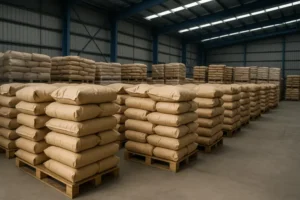Decolorization is one of the most important applications of wood-based activated carbon, especially in food processing, pharmaceuticals, beverages, amino acids, herbal extracts, and organic chemicals. Thanks to its high porosity and fast adsorption kinetics, wood powder activated carbon is widely used for removing pigments and organic impurities.
However, in real production, decolorization efficiency varies greatly due to both material characteristics and process conditions. The following sections summarize the key influencing factors, with important information presented in tables for clarity.
1. Raw Material Quality and Carbon Structure
1.1 Wood Species and Characteristics
Different wood species result in distinct pore structures after carbonization and activation. This directly affects decolorization efficiency.
| Wood Characteristic | Softwood | Hardwood | Impact on Decolorization |
|---|---|---|---|
| Cell wall thickness | Thin | Thick | Influences pore formation |
| Lignin content | Lower | Higher | Affects activation behavior |
| Micropore development | Good | Moderate | Determines adsorption capacity |
1.2 Activation Process Parameters
Activation method and degree influence pore structure and surface chemistry.
| Parameter | Effect on Carbon | Impact on Decolorization Efficiency |
|---|---|---|
| Activation temperature | Determines pore opening | Higher temperature → more micropores; risk of collapse if excessive |
| Steam dosage | Affects pore expansion | Too little → low activity; too much → pore widening |
| Activation time | Controls degree of burn-off | Under-activation = low capacity; over-activation = structural damage |
2. Pore Structure and Surface Chemistry
2.1 Pore Size Distribution
Both micropores and mesopores play essential roles in decolorization.
| Pore Type | Size Range | Main Function in Decolorization |
|---|---|---|
| Micropores | < 2 nm | Capture small/mid-sized pigment molecules |
| Mesopores | 2–50 nm | Improve diffusion rate and reduce adsorption resistance |
2.2 Surface Functional Groups
Surface oxygen-containing groups such as carboxyl, lactone, and phenolic hydroxyl groups influence chemical affinity, polarity, and the adsorption mechanism. These groups help enhance interaction with chromogenic substances.
3. Process Parameters During Application
3.1 Dosage of Activated Carbon
Typical dosage ranges from 0.05%–0.5% depending on chroma and impurity load.
| Dosage Level | Result |
|---|---|
| Too low | Incomplete decolorization |
| Appropriate | Efficient color removal and stable filtration |
| Too high | Higher cost and increased filter load |
3.2 Contact Time
| Contact Time | Expected Result |
|---|---|
| Too short | Partial adsorption |
| Optimal | Maximum color removal |
| Excessively long | Minimal additional benefit |
3.3 Temperature and pH
| Parameter | Recommended Range | Impact |
|---|---|---|
| Temperature | 40–80°C | Higher temp increases diffusion; too high may reduce adsorption for some pigments |
| pH | Slightly acidic | Enhances adsorption of many organic pigments |
4. Impurities and Competitive Adsorption
High concentrations of impurities reduce available adsorption sites. Common interfering substances include polysaccharides, proteins, humic substances, and metal ions.
Pre-treatment such as filtration, coagulation, and pH adjustment can significantly improve decolorization efficiency.
5. Mixing and Filtration Efficiency
5.1 Mixing Uniformity
Good mixing ensures full contact between activated carbon particles and color molecules, improving adsorption rate and stability.
5.2 Filtration Method
| Filtration Condition | Result |
|---|---|
| Good filtration | Clear solution, minimal carbon leakage |
| Inadequate filtration | Carbon fines remain, affecting clarity |
| Use of filter aids | Improves flow rate and solution purity |
6. Selecting the Right Wood Powder Activated Carbon
When choosing a grade, consider the following parameters:
| Key Parameter | Importance |
|---|---|
| BET Surface Area | Determines adsorption capacity |
| Methylene Blue Value | Indicates mesopore capacity |
| Caramel Decolorization | Directly reflects decolorization strength |
| Particle Size | Affects filtration and dispersion |
| Ash Content | Critical for food/pharma applications |
| pH & Soluble Impurities | Affect downstream processes |
Conclusion
The decolorization efficiency of wood powder activated carbon is influenced by raw material characteristics, activation conditions, pore structure, surface chemistry, and process parameters. By selecting the right carbon grade and optimizing dosage, temperature, pH, mixing, and filtration, manufacturers can achieve stable, efficient color removal across food, pharmaceutical, chemical, and biotech applications.
With its rich pore structure and fast adsorption kinetics, wood-based activated carbon remains one of the most reliable solutions for advanced decolorization processes.
Article Keywords: wood powder activated carbon, wood-based activated carbon, decolorization efficiency, food-grade activated carbon, pharmaceutical activated carbon, pore structure, activation method, BET surface area, methylene blue value, caramel decolorization, adsorption kinetics



